Wołomin
Borough of Wołomin, Wołomiński District, Mazowieckie VoivodshipType of place
The area of the sports club “Huragan Wołomin”, the so-called “Glinki”.Information about the crime
In August 2021, we recorded an eyewitness account of the extermination of the Jews of Wołomin. Tadeusz Kielak, born in 1932. witnessed the killing of Jews in the area of today’s sports club “Huragan Wołomin”, which was included in the Wołomin ghetto during the war. At the beginning of the 20th century, there was a brickyard on the site of the later sports club. The remains of its operation were excavations and ponds that are still there.
“There were banks there and they killed them under those banks. We watched it all… They would go to the pits, if any people still had wedding rings, they would take them, pluck out their gold teeth. I was eleven years old. We watched it all with curiosity, there were a lot of kids there. My uncle wrote down on a piece of paper the dates and the number of people killed. He counted 416 people. […] They were bringing them here. They placed these Jews here and dug a hole first. There were probably 15 or 20 people here. Later they took these Jews, pushed them down and shot them. I remember there was a little child there. [The German] took him, lifted him by the neck, shot him at them and threw him. One thing surprised me. As I stood at the window and looked at it, I saw a flash. And after a while I heard a bang. That is how the laws of physics work: light travels faster than sound. I was surprised that it wasn’t until the baby was thrown that I heard a bang. It couldn’t be because they threw him there. Then I was told it was a law of physics: light goes faster than sound… (Wołomin on August 12, 2021)
Kielak’s article from 1990 states that the largest number of executions on the premises of the current sports club took place after the liquidation of the Wołomin ghetto:
“Those who were hiding or returning to the ghetto were shot in a nearby meadow, in the place where today the stadium is located. For several days, the Germans organized hunts for Jews hiding in nearby villages, meadows and groves. From the windows of nearby houses, terrified residents watched the brutal public executions. The military policemen grabbed the hands of babies and small children, shot them in the back and threw them into the pits previously dug by their fathers. The resistant ones were forced into the pits, they were shot to injure them and the next ones were ordered to cover them with dirt. It often happened that after shooting a group of several people, they knocked out their teeth, broke off fingers with gold rings. In total, 416 people were murdered there after the liquidation of the ghetto.” (Kielak, 1990)
Zbigniew Brzuszczyński, a resident of Wołomin, gives a similar number of shootings victims in the area of the present football field:
“On the day of the liquidation of the ghetto on October 5, 1942, the Germans murdered all those who resisted, the elderly, the sick and the disabled with shots. On the very day of the liquidation of the ghetto, about 400 people died from murderous bullets. […] On that tragic day and on the following days, people were dragged out of houses, attics and basements to Piaski (now a stadium) and after the victims had dug pits, murderous shootings were carried out. Several to several dozen people were shot. They also murdered young children and entire families.” (301/7041 AŻIH)
Tadeusz Kielak remembers the murder of a family of eight: “It was terrible. I remember that they already liquidated the ghetto and they found the family on the first floor, at Orwida [street]. There were eight people, including small children. They were walled up there, they were trying to hide. The child was crying, and the Germans were still checking the ghetto area. They heard a baby cry, walled up somewhere, apparently the walls were still fresh. They took those people and led them away. They killed all eight of them right there, in that stadium. (Wołomin, August 12, 2021)
The area of today’s sports club has become a place of mass burials of the victims of the Holocaust. Meanwhile, the prisoners of the Wołomin ghetto, who died of hunger, exhaustion or diseases, were buried in random places, close to their then-place of residence:
“The death rate in the ghetto was high, and the bodies could not be taken to the cemetery because it was forbidden to leave the ghetto [the Jewish cemetery was located outside the boundaries of the Wołomin ghetto, today Andersa street], so people were buried in backyards and other places like this. They are hard to find now. When one or two family members died, they would bury them in the backyard. Nobody saw it. Their remains are probably still out there somewhere.”
Tadeusz also remembers the liquidation of the Wołomin ghetto:
“There was a terrible rush from four in the morning. We went out in front of the gate, I’ll show you where. We could see everything from there. They separated men from women and children. The men had to kneel and the women sat with the children. And so it went on. Around eight or nine o’clock they had all been killed, because the Germans came here at four in the morning and brought everyone here.”
The Register of Killing Sites and Crimes in the former warszawski district records the following events in Wołomin:
– In January 1940 a hat maker from Kościelna street, named Icek, was murdered on the street. The German military policeman kicked his victim until he lost his life.
– On August 12, 1943, Schupo (Schutzpolizei) officers shot two Jews.
– In September 1944 Wehrmacht soldiers and military policemen shot 7 people of Jewish nationality.
The Register contains information about executions of Jews that took place on the premises of the “Huragan” sports club. Meanwhile, in the questionnaires of The Chief Commission for the Examination of German Crimes in Poland, there is information about the murder of 620 people in October 1942. They were Jews from the ghetto in Wołomin with unknown names, from children to old people. The remains of the victims were buried in the so-called Glinianki in 3 graves, approx. 200 bodies in one pit. The questionnaire is dated May 22, 1968. There is no information about the exhumation.
We also have an undated scout alert prepared by members of the scout team named after Hanka Sawicka from Wołomin. The reconnaissance report also mentions Glinki (Glinianki) as the place where Jews were shot. “Before the war, there was a distillery in Glinianki. During the war, Jews were massacred there. The massacre was carried out on the premises of the current sports facility.” (IPN Gk 195 / XV / 33)
The questionnaire about the camps, drawn up in the 1940s, on the ghetto in Wołomin, describes Glinki as a Jewish cemetery, probably due to the number of people buried there. The questionnaire on mass executions and mass graves from the same period states that 620 people, ranging in age from old people to children, died in the so-called Glinki. The bodies of the victims are probably buried in three graves, approx. 200 bodies in each.
According to Tadeusz Kielak, the remains of the victims of the Holocaust, buried in the area of the sports club, were exhumed right after the war, at the turn of the 1940s and 1950s, and moved to the Jewish cemetery in Warsaw.
“When the stadium was being built here, bones were dug out of the pits and taken to the Jewish cemetery in Warsaw. The entire cemetery [in Wołomin] was destroyed. And during the occupation there were still tombstones with inscriptions, but the Germans did not keep an eye on it. Everything was falling apart. Peasants would come there and take the tombstones to use as the foundations.” (Wołomin, 12 sierpnia 2021 r.)
Sources
Transkrypcje
Contact and cooperation
We are still looking for information on the identity of the victims and the location of Jewish graves in Wołomin. If you know something more, write to us at the following address: fundacjazapomniane@gmail.com.
Bibliography
The Register of Killing Sites and Crimes committed by the Germans in Poland between 1939 and 1945, warszawskie voivodeship, Warsaw 1984
IPN BU 2448/1066, executions of the Jewish population in Wołomin
IPN GK 195/XV/33, executions of the Jewish population in Wołomin
Recording of the Zapomniane Foundation (audio), Tadeusz K., resident of Wołomin b. 1932, keywords: Jewish graves in Wołomin, Huragan Wołomin, the ghetto in Wołomin; the interview was conducted by Agnieszka Nieradko and Andrzej Jankowski, Wołomin, August 12, 2021.
Kielak “ Tragedia ludności żydowskiej w Wołominie” in Pismo Wołomina. Dwutygodnik Ziemi Wołomińskiej no. 8 26.01.1990 r.
301/7041 AŻIH The testimony of Zbigniew Brzuszczyński
We have collected the materials about this village thanks to the funding provided by the International Holocaust Remembrance Alliance as part of the project “The rural Holocaust. Collecting and safeguarding the never recorded testimonies 100 forgotten Jewish graves 2021-2022” and also thanks to the support of the Embassy of the Federal Republic of Germany in Warsaw.
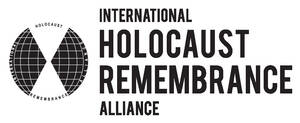
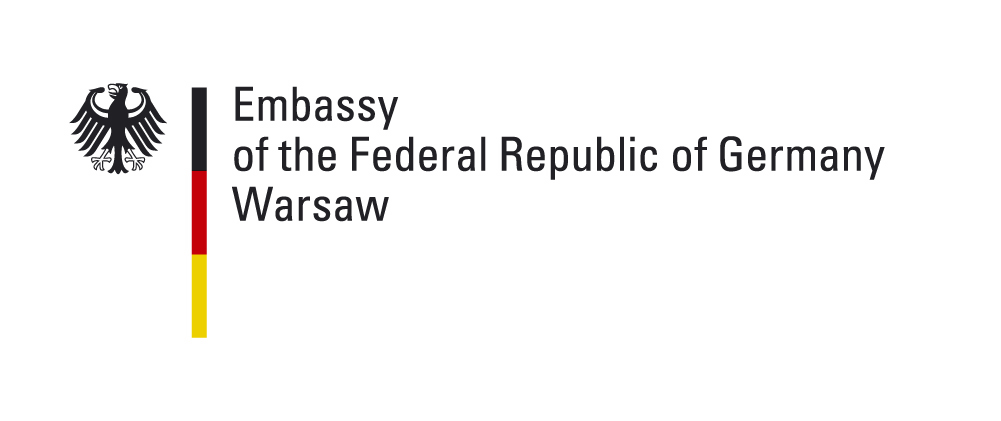
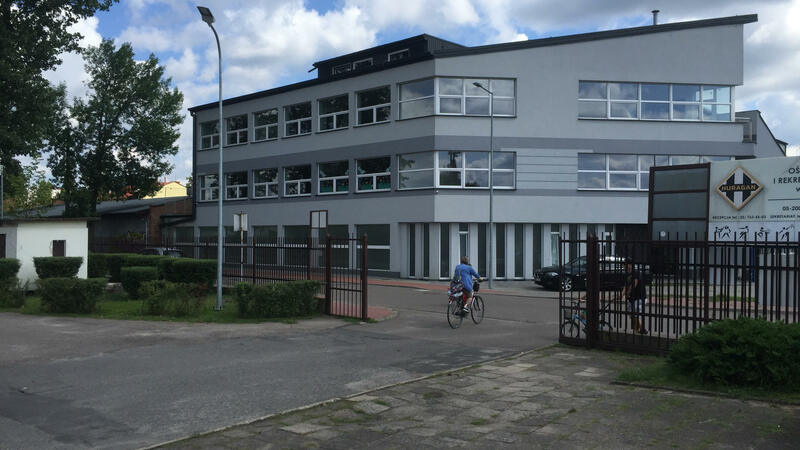 Wołomin zdjęcie 1 - wejście na teren stadionu Huragan
Wołomin zdjęcie 1 - wejście na teren stadionu Huragan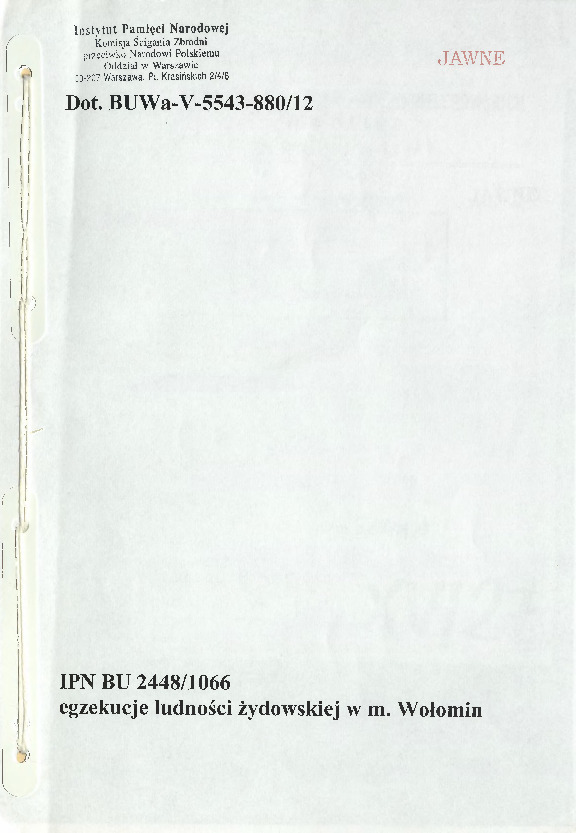 Egzekucje ludności żydowskiej w m. Wołomin
Egzekucje ludności żydowskiej w m. Wołomin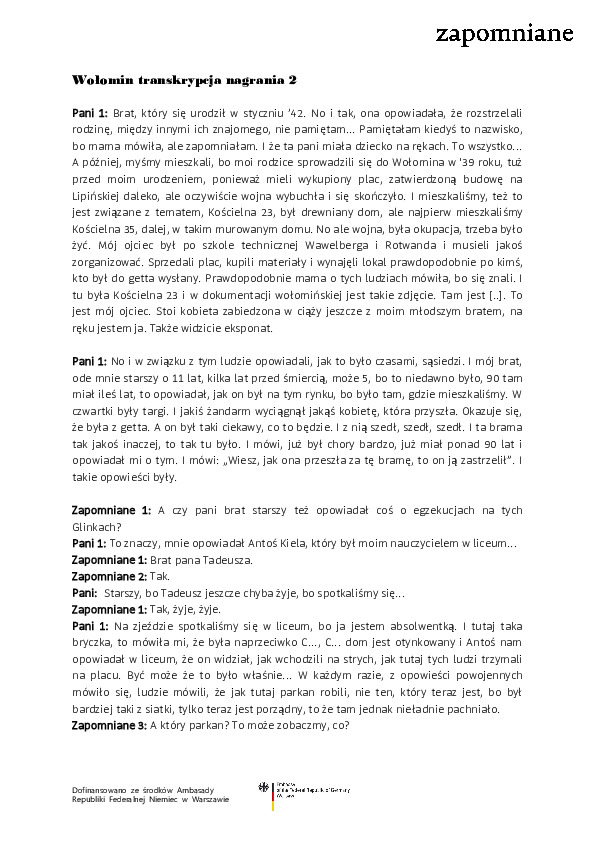 Wołomin transkrypcja 2
Wołomin transkrypcja 2